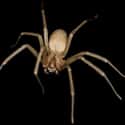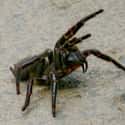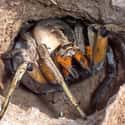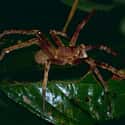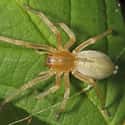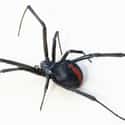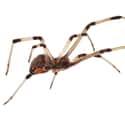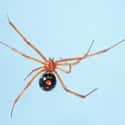-
(#1) Brown recluse spider
- Loxosceles reclusa
Size: 0.24 to 0.79 inches (6 to 20 mm).
Location: Southern and Central North America.
Distinguishing Features: Most examples are a light brown, but some can be dark-brown in color almost looking black.
Why You Should Be Scared: The Brown Recluse Spider is one of the most feared of all spiders due to their highly necrotic venom. If a person is bitten, they generally don't need to worry about death, but rather about receiving a mutilating scar thanks to the dead tissue resulting from the bite. If left untreated, the necrosis can spread over a wider area requiring surgery and even amputation in severe cases.
-
(#2) Sydney funnel-web spider
- Atrax robustus
Size: Can reach a size of 2 inches (5 cm)
Location: Literally, on your back right now!!! Sorry, it had to be done. They are native to Eastern Australia and are most often found within 62 miles (100 km) of the city of Sydney.
Distinguishing Features: Instead of weaving a web meant to trap insects, they weave a tubular burrow with collapsed tunnels.
Why You Should Be Scared: If one of these nasty little buggers bites you, you should find some antivenom as fast as possible. Their venom is composed of a compound, which makes it highly toxic to humans. When they bite, they tend to strike multiple times—delivering enough venom to kill with each strike. Children are at a higher risk than adults due to their size. There has been one recorded case of a small child dying within only 15 minutes of being bitten.
-
(#3) Wolf spider
- Lycosidae
Size: The largest of the species can reach a length of 1" (2.5 cm).
Location: Wolf Spiders make up more than 2,300 species and are spread across the globe.
Distinguishing Features: Wolf Spiders do not weave webs, but instead, hunt their prey on the ground.
Why You Should Be Scared: Wolf Spider venom causes a great deal of swelling, itching, and pain at the bite-site with some subspecies' venom resulting in necrosis. Necrosis causes tissue to die and rot away, which is incredibly painful and damaging to anyone who gets bitten. When threatened, Wolf Spiders will bite and continue to inject venom until they are emptied.
-
(#4) Brazilian wandering spider
- Phoneutria
Size: They can reach a length of up to 1.89" (48 mm).
Location: Tropical regions of South America with a single subspecies found in Central America.
Distinguishing Features: Many examples possess a dark linear stripe on their dorsal pedipalps with a single black line running along the dorsal carapace. They also have disturbingly large fangs comparable to their body size.
Why You Should Be Scared: Their venom contains a potent neurotoxin, which can become deadly by causing a loss of muscle control and breathing problems resulting in paralysis and asphyxiation. The venom also causes intense pain and inflammation following the bite. These spiders should be avoided at all costs due to the pain they cause, but some subspecies will bite without delivering venom in what is called a "dry" bite. It is believe they do this to conserve venom, but this also means that they tend to have a full supply at most times.
-
(#5) Black widow spider
- Latrodectus hesperus
Size: 0.5" (13 mm) in length.
Location: Black Widow Spiders are distributed worldwide and contain 31 recognized species.
Distinguishing Features: Black Widow Spiders are typically black across their entire body and legs with a large, red hourglass shape on the underside of their thorax.
Why You Should Be Scared: A Black Widow Spider's venom contains a deadly latrotoxin, which can result in severe muscle pain, abdominal cramps, tachycardia, and muscle spasms. Bites are not typically considered life-threatening, but are incredibly painful. Death can occur in rare cases, but those deaths are often attributed to the Mediterranean Black Widow subspecies. The spiders are unusually aggressive and will deliver a full dose of venom on most strikes.
-
(#6) Yellow sac spider
- Cheiracanthium inclusum
Size: Very small, only 5 to 10 mm in total length.
Location: Northern Europe to Japan, from Southern Africa to India and Australia.
Distinguishing Features: The Yellow Sac Spider's most distinctive feature is its bright yellow color
Why You Should Be Scared: The venom of a Yellow Sac Spider is necrotic and causes lesions in humans at the site of a bite. Bites cause a great deal of pain and are considered a threat of transmitting a MRSA infection, which is a Methicillin-resistant Staphylococcus Aureus. These are difficult to treat due to the resistant nature of the Staphylococcus.
-
(#7) Redback Spider
Size: Relatively small only reaching a length of around 0.16" (4 mm)
Location: It is believed to have originated in the south Australian and Western deserts, but now exists across the entire continent, Southeast Asia, and New Zealand.
Distinguishing Features: Most possess a red band along their abdomen. The females are typically black while the males can be a light brown.
Why You Should Be Scared: Given all the deadly animals in Australia, the Redback Spider holds the distinction of being the animal historically responsible for requiring antivenom treatment more than any other animal on the continent. There are between 2,000 and 10,000 bites occurring annually and the venom causes intense pain in humans and represents a greater threat to small children and the elderly.
-
(#8) Brown Widow Spider
Size: 0.5" (16 mm) in length.
Location: Brown Widow Spiders were thought to originate in South America, but have since spread across most of the world with populations in South Africa, the United States, Afghanistan, and elsewhere.
Distinguishing Features: Most examples of the species possess a dark brown body with light brown legs.
Why You Should Be Scared: Brown Widow Spiders possess a deadly venom, but do not often have enough venom within their bites to result in the death of a human. Their bites result in painful and itchy lesions. They present a greater threat to children and the elderly, but don't often require medical treatment following a bite except for extreme cases.
-
(#9) Golden silk orb-weaver
Size: 1.5 to 2" (4.8 to 5.1 cm).
Location: They are found all over the world, but typically live in warmer climates.
Distinguishing Features: The Golden Silk Orb-Weaver Spider is so-named due to the intricate and beautiful webs they weave. They have especially long legs, which can be colored differently on each segment.
Why You Should Be Scared: Golden Silk Orb-Weaver Spiders are not typically dangerous to humans, but they are frightening to behold due to their relatively large size. People often find them after walking directly into their webs and then frantically freaking out when a large spider finds itself wrapped around a person's face.
-
(#10) Red Widow Spider
Size: Red Widow Spiders are very small, but pack a deadly punch in their venom.
Location: Central and Southern Florida, found mostly in sand dunes near the Sand Pine tree.
Distinguishing Features: Most possess dark red legs with a black thorax spotted with red spots and yellow rings.
Why You Should Be Scared: Their venom is thought to be deadly, but given the spider's size, it is not thought to possess enough venom in a single individual to result in the death of a human. Bites can cause pain and irritation at the bite-site, but the spider seldom comes into contact with humans due to its limited range.
New Random Displays Display All By Ranking
About This Tool
There are about 40,000 different spider species living on the earth. Whether they are crawling on the web with eight legs or rushing out of their nests, which are signals that they are ready to pounce and kill prey. Many terrifying spiders are nightmares. Although many spiders are harmless, there are some particularly large and poisonous species that can kill humans.
Like most animals, spiders are afraid of humans, and some spider species are beautiful but deadly. The random tool introduced 10 of the scariest spiders on the planet and they are all vital to keep the ecological balance.
Our data comes from Ranker, If you want to participate in the ranking of items displayed on this page, please click here.










